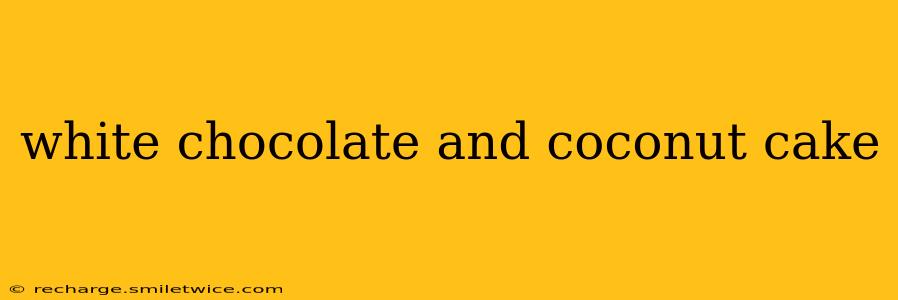White chocolate and coconut—a match made in tropical paradise! This decadent combination creates a cake that's both luxuriously rich and refreshingly light. This post will explore everything you need to know about baking the perfect white chocolate and coconut cake, from choosing the right ingredients to mastering the perfect frosting. We'll also answer some frequently asked questions to help you achieve baking bliss.
What makes a white chocolate and coconut cake so delicious?
The magic lies in the contrasting textures and flavors. The creamy sweetness of white chocolate perfectly complements the subtle sweetness and tropical essence of coconut. Whether you use shredded coconut, coconut flakes, or coconut milk, the incorporation of coconut adds a delightful chewiness and a distinct, fragrant aroma that elevates the cake to another level. The combination is incredibly versatile, allowing for variations in texture and flavor profiles depending on your preferences and baking expertise.
What are the best ingredients for a white chocolate and coconut cake?
Using high-quality ingredients is crucial for achieving the best results. Here's a breakdown of key ingredients and why they matter:
- White Chocolate: Opt for a good quality white chocolate with a high percentage of cocoa butter for a smoother, richer flavor. Avoid using chocolate chips as they often contain added stabilizers that can affect the texture of the cake.
- Coconut: Choose unsweetened shredded coconut for baking. Sweetened coconut will make the cake overly sweet. You can also experiment with toasted coconut for added depth of flavor and a pleasant crunch. Coconut milk adds richness and moisture.
- Flour: All-purpose flour is generally recommended, but cake flour can create a slightly lighter and more tender crumb.
- Butter: Unsalted butter is best, as it allows you to control the salt level in the cake.
- Eggs: Large eggs provide structure and richness.
- Baking Powder & Baking Soda: These leavening agents are essential for a light and airy cake.
How do I make a moist white chocolate and coconut cake?
Moisture is key to a delicious cake. Here are some tips to ensure your cake is perfectly moist:
- Don't overbake: Overbaking is the biggest culprit of dry cakes. Use a cake tester to check for doneness; it should come out clean when inserted into the center.
- Use fresh ingredients: Fresh baking powder and baking soda are essential. Old leavening agents can result in a flat cake.
- Add moisture: Incorporating sour cream, buttermilk, or even yogurt can add extra moisture to the cake batter.
- Properly Cream Butter and Sugar: Creaming butter and sugar thoroughly incorporates air into the batter, leading to a lighter and moister cake.
What kind of frosting goes well with white chocolate and coconut cake?
The possibilities are endless! However, some classic pairings include:
- Cream Cheese Frosting: The tanginess of cream cheese cuts through the richness of the white chocolate and coconut, creating a beautiful balance of flavors.
- Coconut Cream Frosting: A simple coconut cream frosting enhances the coconut flavor of the cake, creating a cohesive and tropical taste experience.
- White Chocolate Ganache: A rich and decadent white chocolate ganache adds an extra layer of luxuriousness and perfectly complements the cake's flavor profile.
Can I make a white chocolate and coconut cake without eggs?
While eggs contribute to the structure and richness of the cake, you can find egg-free recipes online that use flax eggs or applesauce as substitutes. The texture might be slightly different, but the flavor will still be delicious.
Is it difficult to make a white chocolate and coconut cake from scratch?
While it might seem daunting, making a white chocolate and coconut cake from scratch is achievable even for beginner bakers. Following a well-written recipe carefully and paying attention to detail will ensure success. Don't be afraid to experiment and adjust the recipe to your liking!
What are some variations on a white chocolate and coconut cake?
Get creative! Consider these variations:
- Adding Pineapple: Incorporate chunks of fresh pineapple into the batter for an extra burst of tropical flavor.
- Using Different Types of Coconut: Experiment with toasted coconut, coconut flakes, or desiccated coconut for varying textures and flavors.
- Infusing with Extracts: Vanilla, almond, or even rum extract can add another layer of complexity to the flavor profile.
With its delightful combination of textures and flavors, a white chocolate and coconut cake is sure to impress. Whether you're a seasoned baker or a kitchen novice, this recipe is a rewarding experience that will leave you with a delicious and memorable cake. Remember to experiment and have fun with it!
